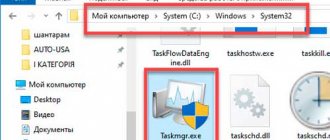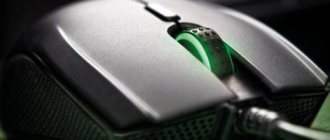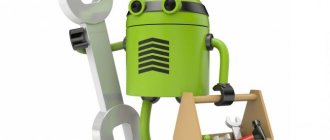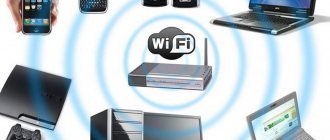Sometimes a user of Windows 10, 8 or Windows 7 may encounter the fact that his computer (or laptop) does not see the mouse - this can happen after system updates, hardware configuration changes, and sometimes without any obvious previous actions at all.
This instruction will detail why the mouse does not work on a Windows computer and what to do to fix it. Perhaps during some of the actions described in the manual you will find the guide How to control the mouse from the keyboard useful.
The main reasons why the mouse does not work in Windows
First, let's talk about the factors that most often cause the mouse to not work in Windows 10: they are relatively easy to recognize and correct.
The main reasons why a computer or laptop does not see the mouse are (later all of them will be discussed in detail)
- After updating the system (especially Windows 8 and Windows 10), there are problems with the operation of USB controller drivers and power management.
- If this is a new mouse, there are problems with the mouse itself, the location of the receiver (for a wireless mouse), its connection, or the connector on the computer or laptop.
- If the mouse is not new - an accidentally removed cable/receiver (check if you haven’t already), a dead battery, a damaged connector or mouse cable (damage to internal contacts), connection via a USB hub or ports on the front panel of the computer.
- If the motherboard on the computer was changed or repaired, the USB connectors are disabled in the BIOS, the connectors are faulty, or they are not connected to the motherboard (for USB connectors on the case).
- If you have some kind of special, terribly sophisticated mouse, in theory it may require special drivers from the manufacturer (although, as a rule, the basic functions work without them).
- If we are talking about a fully working Bluetooth mouse and laptop, sometimes the cause is accidentally pressing the Fn + airplane_mode keys on the keyboard, turning on the Airplane mode (in the notification area) in Windows 10 and 8, disabling Wi-Fi and Bluetooth. More details - Bluetooth does not work on the laptop.
Perhaps one of these options will help you figure out what is causing the problem and correct the situation. If not, we try other methods.
What does the solution to the problem depend on?
Here a lot will depend on what type of manipulator you are currently using. Here's what you can connect to your laptop for greater ease of use:
- Wired mouse;
- Wireless mouse;
- Working with the touchpad.
Let's take a closer look at each option.
What to do if the mouse does not work or the computer does not see it
And now about what exactly to do if the mouse does not work in Windows (we will talk about wired and wireless mice, but not about Bluetooth devices - for the latter, make sure that the Bluetooth module is turned on, the battery is “intact” and, if necessary, try pairing again devices - remove the mouse and join it again).
To begin with, there are very simple and quick ways to find out whether the problem is in the mouse itself or in the system:
- If you have doubts about the functionality of the mouse itself (or its cable), try checking it on another computer or laptop (even if it worked yesterday). At the same time, an important point: the glowing mouse sensor does not indicate its functionality and that everything is in order with the cable/connector. If your UEFI (BIOS) supports control, try going into the BIOS and checking if the mouse works there. If yes, then everything is fine with it - problems at the system or driver level.
- If the mouse is connected via a USB hub, to the front panel of the PC, or to the USB 3.0 connector (usually blue), try connecting it to the back of the computer, ideally to one of the first USB 2.0 ports (usually the top ones). Similarly on a laptop - if connected to USB 3.0, try connecting to USB 2.0.
- If you connected an external hard drive, printer, or something else via USB before the problem appeared, try disconnecting this device (physically) and then restarting your computer.
- Look into the Windows Device Manager (you can start from the keyboard like this: press the Win + R keys, enter devmgmt.msc and press Enter, to move through the devices you can press Tab once, then use the down and up arrows, the right arrow to open the section) . See if the mouse is there under "Mice and other pointing devices" or "Devices H >These are the main methods that can help when it's not Windows. However, it often happens that the reason is the incorrect operation of the OS or drivers; this often occurs after Windows 10 or 8 updates.
What are the differences between computer mice?
There are two main types - optical and laser.
Both technologies are very similar. Both use a beam of light that bounces off a surface and informs the computer of the mouse's position. Laser technology allows for much more precise interaction, making it a popular choice for gamers and other users who need precise cursor targeting.
Laser also allows you to get a higher DPI, which is especially important for gamers.
For the average user, dots per inch above 1000 are more than enough, and there are practically only such models on the market.
The advantage of optical technology is that they are simply cheaper. Even in the case of gaming ones, the models are very similar to each other, differing only in the sensor and greatly in price.
If you want to use your mouse on almost any surface, you should look at one with a laser sensor.
It will also not work on just a sheet of glass or other transparent surfaces, although there are exceptions, for example, the Logitech Performance Mouse MX is equipped with Laser Tracking technology, which allows it to be used on glass (with a thickness of 4 mm above), since the laser is so precise, which can reflect the beam from microscopic imperfections in the glass.
An alternative to optical and laser sensors is provided by Microsoft with BlueTrack technology, using a wide beam of blue light.
It can work on any surface (except glass and mirror surfaces) while ensuring precision. Although it is not the best solution for hardcore gamers, office users will feel the difference in technology.
Checking mouse settings
To open the mouse settings, press the Win+R button combination, enter the control mouse command in the “Run” window that appears and press Enter.
Alternatively, open the Windows Control Panel, and in the “Hardware and Sound” section, click on the “Mouse” link. See screenshot below.
Hardware and Sound - Mouse (Windows Control Panel)
Next, you need to open the “Pointer Options” tab and set the speed of its movement (some people have the speed set too low and they think that the mouse is slowing down...).
Changing the mouse
If you are using a USB mouse, unplug it from your computer and plug it into a different USB port. If you need to disable something else to free up space, do so. Just unplug anything that's not vital, and try to avoid unplugging your USB keyboard, although that's not that important.
Move the mouse to a different USB port. If you move the mouse and it works, the problem is with the USB port. If the mouse still doesn't work, the problem is with the mouse. If the problem is with the mouse, try it on another computer. If it still doesn't work, replace the mouse. Then grab another USB mouse and try the same.
Batteries
Another reason for cursor malfunctions is lack of mouse charge. If the battery runs out, the device does not stop responding immediately, but gradually. Prerequisites:
- The indicator light (if present) begins to dim;
- The buttons stop responding, respond with a delay or delay (if you remove and insert the batteries and swap them, the problem temporarily disappears);
- The mouse cursor twitches: it is difficult to select text, it responds late, incorrectly, etc.
- The last stage is when the mouse stops working completely.
If the device has not been used for a long time, and there are batteries left inside, the contacts inside the case may oxidize. Because of this, not only the power source will be broken, but also the mouse itself.
The solution to the problem is to replace the batteries inside the device. The mouse will immediately start working as it should.
Check your mouse drivers
Drivers contain instructions that allow Windows to interpret specific hardware commands for a given device. They are like an interpreter that allows Windows to talk to the hardware and vice versa. If something happens to these drivers, they will not be able to communicate properly.
The mouse does not work, look at the device manager
- Press Shift+F10 and select "Device Manager".
- Select Mice and other pointing devices. If the item has a red circle or yellow triangle, there is a problem.
- Double-click other pointing devices and select your mouse.
- Right-click and select Update Driver.
- Select Find Disk automatically and let Windows find the best one.
Drivers and their influence on the smooth operation of the cursor in Windows 10
0x0000003b Windows 7 - solution to this problem
Drivers are specific software that allows Windows to communicate with the hardware of other devices.
Note! If the cursor freezes, it is recommended to check the drivers of the mouse, video card and chipset; update or reinstall them if necessary.
What about CPU and disk usage?
High load on the processor or hard drive can seriously affect the performance of the mouse (and the entire system as a whole). At the same time, freezes are possible (for 1-5 seconds, when the mouse does not move at all).
? By the way, if freezes occur frequently, the disk is constantly loaded at 90-100% (even in Windows safe mode) and it is difficult to copy any file from partition to partition - this may indicate a hardware problem with the disk...
For diagnostics, try booting from a LiveCD and check the operation of the system as a whole.
To view the current load on the CPU and disk, you can use the task manager (to open it, press the combination Ctrl+Alt+Del or Ctrl+Shift+Esc).
Touchpad
If after updating Windows 10 the mouse and/or touchpad (touchpad) does not work, then in this case we again turn to the “Device Manager” and check the functionality of the equipment. And also in the settings, make sure there is a checkmark next to the item “Work with the mouse” and reboot the laptop. If these steps do not help, then you should contact the service center.
Keyboard
If after updating Windows 10 the mouse and/or keyboard does not work on a laptop or desktop PC, then do the following:
- We check the integrity of the wires and the serviceability of the ports.
- We perform a banal reboot.
- We go to “Settings” through “Start” (provided that the mouse is working), and from there to “Special Features”.
- Turn on the on-screen keyboard in the corresponding tab by moving the slider to the “ON” position.
- Press the on-screen keyboard buttons – Win and R to open the “Run” window, in which we enter the “regedit” command.
- The Registry Editor will open, in which you need to go to the folder <4D36E96B-E325-11CE-BFC1-08002BE10318>.
- To get there, first expand the HKEY_LOCAL_MACHINE directory.
- It displays the contents of the SYSTEM and CurrentControlSet directories.
- The folder we need, indicated above, will be found after expanding the Control section, and in it the Class folder.
- We are looking for the UpperFilters parameter; if it is not there, then we create it.
- Using the corresponding button on the on-screen keyboard, call up the context menu of the parameter and select the “Change” item.
- We write the value as “kbdclass”, removing everything unnecessary, and reboot the PC.
Finally I will repeat. If the mouse and keyboard do not work after updating any drivers, then it is enough to use safe mode by rolling back the system to return to the moment when everything was functioning properly. That's all I wanted to say. Share your methods for solving the problems I described.
Increased sensitivity
On the box of each mouse there is a “DPI” mark - this is the value of sensitivity, cursor accuracy and movement speed: how many points within one inch the sensor can distinguish. The lower the indicator, the slower the device responds.
The cursor usually shakes when the DPI is too high, when the sensor detects false positives. Or it twitches on its own at the slightest vibration. Sensitivity can be changed in several ways. First, sometimes there is a special button on the peripheral for setting DPI (usually near the scroll wheel or left key).
:/> Wireless mouse slows down and freezes windows 10
The second way is to use the internal parameters of Windows 7, 8.1 or 10:
- Open “Control Panel” (the section is located in the “Start” menu).
- Go to “Hardware and Sound”, then to “Mouse”.
- Open the “Pointer Options” section and change the sensitivity slider next to the “Move” line.
- Click “Apply”, then “Ok” and close the dialog box.
Example of DPI settings and mouse polling rate
Computer gaming mice have a wide range of settings. Sometimes a special application is used for this. You can find out about the need for additional software if you read the instructions on the box for the mouse. If you adjust the sensitivity, you can get rid of cursor twitching and jerking.











